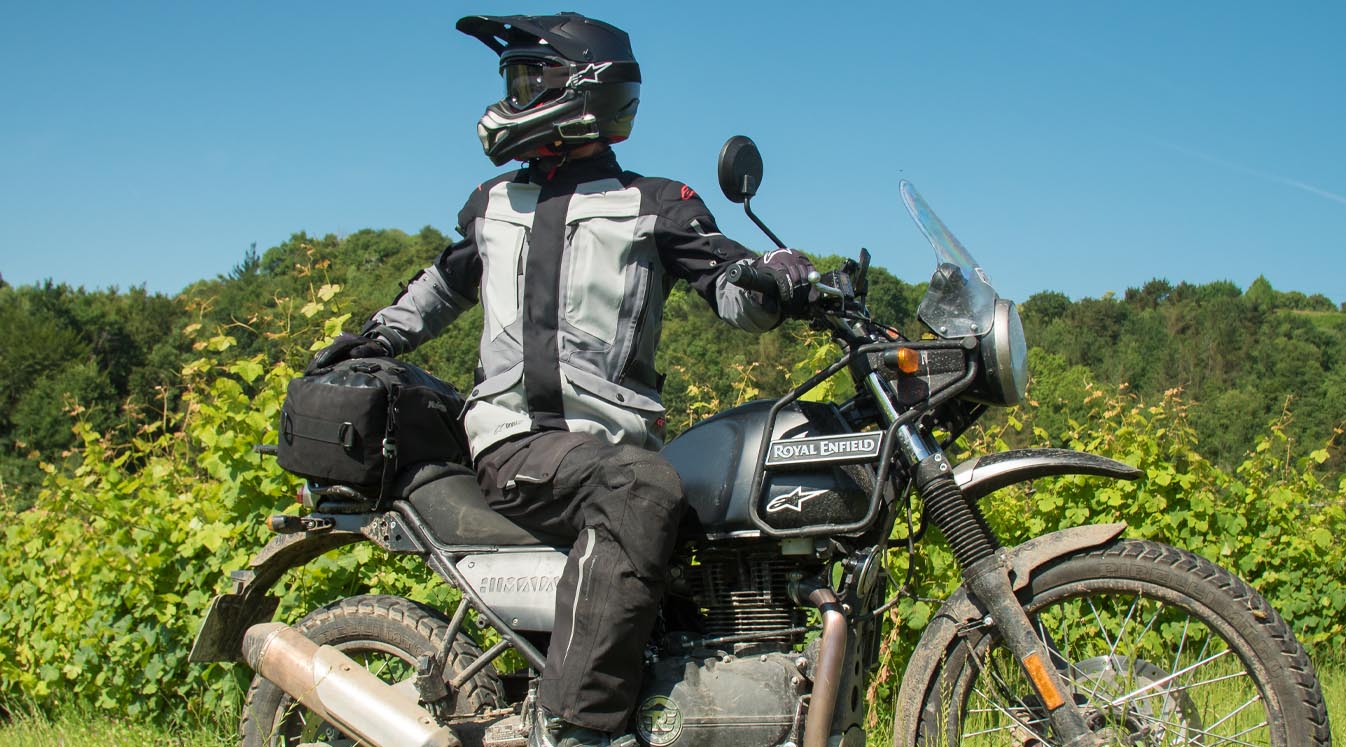
How to Pick Motorcycle Protective Gear
There’s a common saying among motorcyclists: “Dress for the slide, not for the ride.” Riding in shorts and sandals with no helmet might feel good, but what doesn’t feel good is road rash, a broken foot and a permanent brain injury. In other words, no matter what weather conditions you’re riding in, any motorcyclist should be rocking the motorcycle protective gear that will help minimize their injuries in a motorcycle crash.
Picking the right gear is really important, but it doesn’t have to be an overly complicated task. In fact, there are lots of great options for high performance gear that will protect your body without totaling your wallet. You just need to know a few things about what to look for in motorcycle protective gear.
That’s exactly what we’ll talk about in this article. Below, you’ll find a quick and informative guide for how to pick motorcycle protective gear in all of the key areas like helmets, jackets, boots and much more.
The Best Motorcycle Helmets
Your motorcycle helmet is the cornerstone of your riding outfit. It’s the number one must-have for any rider, on any kind of bike, riding at any speed. A lot of different factors go into choosing the right motorcycle helmet, so let’s look at a few of the most important ones:
Design
Several different types of motorcycle helmets are available, including:

– Full-Face: The type of helmet that offers the most protection, both in a crash and against wind and road debris. Remember that facial injuries are common in motorcycle crashes, so a full-face will give you the best protection if you value your jaw, teeth, nose and eyes. Full-face helmets can get hot and stuffy, so make sure to get one with good ventilation.
– Three-Quarters/Open Face: A helmet with a back and sides, but no face protection. These helmets are somewhat less protective than a full-face, and you’ll probably want to add a face shield to keep yourself from taking a piece of gravel in the eye or a bug in the mouth. Modular helmets, which have a flip-up front section, are a good middle ground between three-quarters and full-face.
– Half: The so-called “brain bucket” is the least protective type of helmet. It covers only the top of a rider’s head, with no back or sides. It is, however, definitely better than nothing.
Size and Shape
A helmet needs to fit your head snugly without squeezing too tightly. To find the right helmet size, you need to know your head circumference and head shape. Read up on how to measure your head for a motorcycle helmet and determine which head shape you have before you start trying helmets on.
Safety Ratings
It’s important to pick a motorcycle helmet that has the right safety ratings. The minimum that any helmet should include is a U.S. DOT approval, which means that it is the fairly minimal helmet standards imposed by the U.S. government. A rating from the Snell Foundation or an ECE 22.05 certification are more rigorously tested standards that will help you find a helmet that will actually protect you in a crash. Anything listed as a “novelty helmet” that lacks a U.S. DOT certification is worthless.

Helmet Intercom
Using a motorcycle communication system can make your ride a lot safer and more fun, so consider picking up a motorcycle intercom with a good set of motorcycle helmet speakers at the same time that you choose your helmet. Cardo Systems makes it easy to pick an intercom and a helmet that work like a charm together. Just check our lists of compatible helmets for more information. If you use a half helmet, make sure to pick up a Cardo boom mic kit.
The Best Motorcycle Gloves
A great pair of motorcycle gloves will go a long way toward a more comfortable and enjoyable ride. For one thing, good motorcycle gloves will help your hands stay on the handlebars even in dicey weather or other hair-raising riding situations. That by itself is reason enough to invest in a pair.
Moreover, think about the fact that a motorcyclist’s hands are frequently among the first things to hit the pavement during a crash. A broken wrist, knuckle or finger is no joke, and picking the right gloves can save you from one. With that in mind, here are some tips for choosing motorcycle gloves:
– Most riders will be looking for two things in motorcycle gloves: grip and abrasion resistance. Synthetic materials can provide good performance, but many riders prefer leather materials (cowhide, goat or even kangaroo) for their excellent durability, flexibility and grip. Some of the best glove models include multiple overlapping sections of leather on areas like the palm to provide additional abrasion resistance.
– As with most other types of motorcycle gear, gloves can get pretty hot in warm weather, so look for models that use strategically placed mesh sections or perforations to keep your hands cool. Alternatively, just get an insulated winter pair and a lighter summer pair. Many riders find that the extra cost is worth it in terms of comfort.
– Gloves with built-in “palm sliders” or scaphoid protection are increasingly popular because they help prevent wrist injuries in a crash. Knuckle armor is also a popular protective feature that helps prevent a rider’s knuckles from being crushed in an accident.

– For touring or commuter riders, consider getting a pair of waterproof motorcycle gloves with a fabric treatment like Gore-Tex to keep your hands dry when the weather doesn’t cooperate.
The Best Motorcycle Jackets
Finding the best motorcycle jacket involves a lot more than just choosing the coolest-looking black leather getup on the rack. In fact, although leather jackets are, of course, deeply intertwined with the history of the motorcycle, many jackets now on the market imitate the motorcycle jacket style without providing the safety features that a good piece of motorcycle protective gear should have. When you’re shopping for a motorcycle jacket, think about the following:
– Make sure to look for an actual motorcycle jacket, not just a “motorcycle style” jacket. Look for motorcycle-specific design features such as abrasion-resistant fabric; armor in the elbows, shoulders and back; ventilation points; and good flexibility. Some jackets offer zip-in armor pockets that allow you to customize the jacket with additional armor padding.
– A good motorcycle jacket should extend slightly below your waist to minimize the amount that it rides up in a slide. For the best protection, consider getting a jacket and pants set that snap or zip together.
– There’s no one right answer when it comes to leather vs. textile motorcycle jackets. Leather is still the gold standard for abrasion resistance, and many leather styles beyond the classic cruiser jacket are now on the market for those who prefer a sportier look. However, textile jackets are often less expensive and more specialized while still providing good performance, as well as offering an alternative for vegans and others who aren’t keen on wearing leather.
– Black is a great color for looks, but even a light black jacket will get quite hot in the summer. If you ride somewhere with extreme summer temperatures and you only want to buy one jacket, pay careful attention to the colors of your jacket and think about choosing a lighter color and/or a jacket with removable zip-out liners. Brighter motorcycle jacket colors will also help increase your visibility to other motorists, which is a huge plus for your safety.

– Good all-season motorcycle jackets are available, but they can only do so much if you live somewhere that gets very hot, very cold or both. Much like with gloves, it might make sense to buy both a summer and a fall/winter jacket, especially if you’re going the textile route.
– Prioritize comfort and protection over style, but get a jacket that you’ll actually enjoy wearing. And don’t be afraid to budget a little more for a high-quality motorcycle jacket. It’s probably your second most important piece of protective gear after your helmet.
Experience the Best in Motorcycle Helmet Speakers
The Best Motorcycle Pants
You might look pretty cool riding in your favorite pair of jeans, but everyday fabrics without reinforced elements will leave you exposed to awful road rash in a crash. (Plus, you’ll most definitely destroy the jeans.) Moreover, your everyday pants won’t protect you from the searing heat of the engine that, in case you forgot, is right next to the tender unprotected flesh of your legs.
The answer to these problems is to find a good pair of motorcycle riding pants. Consider these elements in your search for this key piece of motorcycle protective gear:
– Motorcycle pants come in a variety of different styles, from jeans reinforced with layers of Kevlar to leather riding pants. People who commute on a motorcycle often choose the more low-key styles such as armored jeans because they work in a variety of settings, but they usually don’t offer the ventilation or abrasion resistance of purpose-made motorcycle pants.
– As with most other types of motorcycle protective gear, leather or textile will be one of your biggest choices. Leather pants tend to be tougher and are the standard choice for challenging high-speed riding, but textile pants offer more specialized designs and are often more breathable.

– Think about whether you want to wear another layer (like a pair of normal jeans or shorts) under your motorcycle pants. If you do, you may want to buy a pair of looser-cut pants (not necessarily a larger size) so that the combination won’t be too bulky. For those who just need some extra warmth, a moisture-wicking base layer is a great idea.
– Speaking of pants size, pull out the tape measure and find out your exact waist and inseam size before ordering motorcycle pants, especially if the pants you’re considering don’t have built-in fit adjustments. Always use the manufacturer’s size chart rather than guessing how your size lines up.
The Best Motorcycle Boots
Boots are another key element of your motorcycle protection ensemble since your feet will be performing critical tasks like shifting gears. A good pair of motorcycle boots helps keep your feet and legs protected from snags, stubbed toes, road rash and the heat of the motorcycle’s engine.
Leather is by far the most popular material for motorcycle boots, although textile boots aren’t unheard of. Here are some other important characteristics of motorcycle boots to think about:
– Ankle protection is one of the most crucial functions of motorcycle boots. Motorcycle boots should extend at least to the ankle (preferably a little higher) and include built-in ankle support. Ankle armor is also close to a must-have, since broken ankle bones are a common injury from crashes where the rider’s foot becomes trapped under the bike.
– Getting your laces tangled in the motorcycle’s foot controls is obviously something you want to avoid, so motorcycle boots should have their laces recessed into the interior of the boot or an option to hide them such as a zipper.
– Most motorcycle boots include a replaceable reinforced steel or plastic toe, which is particularly important for working the shifter and rear brake comfortably and confidently. Some even have a shifter pad on the left foot to make working the shifter easier on your boots and your toes, or you can purchase one separately that straps to your boot.

Find the Right Motorcycle Communication System for You
The best way to enjoy a motorcycle ride is the safest way, and that means all the gear, all the time. If you’re picking out your first set of gear, see our guide to the best motorcycle gear for beginners as well, and remember to check out our guide to choosing the right motorcycle headset to learn about how Cardo’s motorcycle communication systems can make every ride one to remember.
